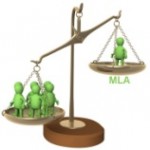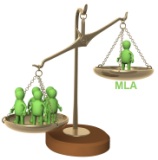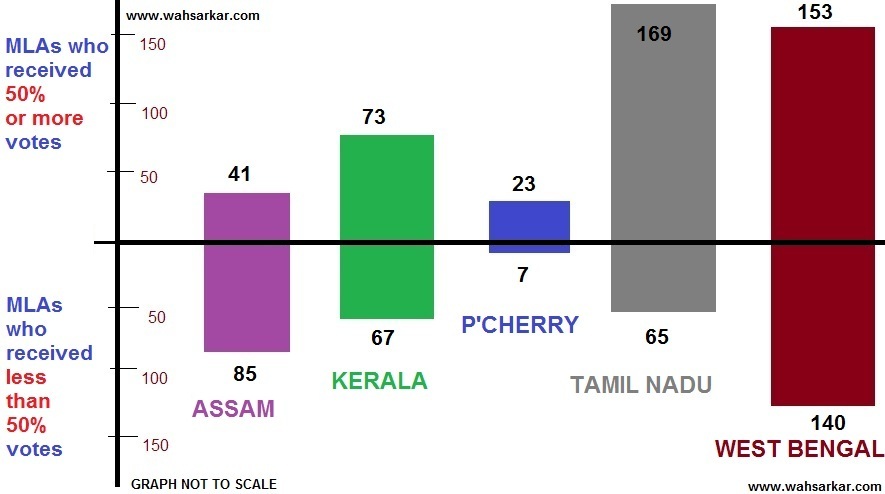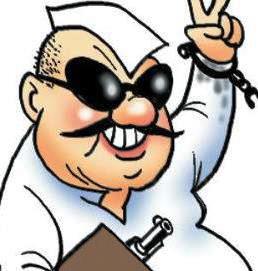Five states went to poll earlier this year. Elections were conducted in a total of 823 assembly constituencies across Assam, Kerala, Puducherry, Tamil Nadu & West Bengal. 364 out of 823 MLAs (i.e. 44%) had more people voting against them than for them. Despite this they won due to the nature of our electoral setup.
Here is a break-up of MLAs sworn in earlier this year:
The above graph shows a split of MLAs between those who managed to receive 50% or more votes versus those who received less than 50% votes of their constituencies. For instance, in Kerala 73 MLAs are such that at least half of the votes polled in their constituency were in their favour. While there are 67 such MLAs who have won despite more than half the polled votes being against them.
To simplify it further, say in a constituency 10 votes were cast. 3 for candidate A. 3 for candidate B and 4 for candidate C. The winner will be candidate C. However those who want candidate C = 4. Those who do not want candidate C = 6.
Worst of the Lot…
Here’s a state wise look at MLAs from the 5 states who had the least percentage of people voting for them:
…And the Best of them
A state wise look at MLAs from the 5 states who had the most percentage of people voting for them:
There have been many suggestions to make it mandatory for the winner of any election to receive at least 50% +1 votes in a constituency. What this could also help do is to reduce caste based voting since often in a constituency, one caste can have a 30-45% presence. Hence just the votes of this one caste are enough for a candidate to win an election.
One of the biggest disadvantages of shifting to the 50%+1 system would be the delays & extra costs of conducting elections again. For this it has been suggested that the top 2 candidates from each constituency where there is no clear winner could contest elections again to determine a definite winner.
All data is as per Election Commission of India.
 Copyright secured by Digiprove
Copyright secured by Digiprove







Or a preferrential voting can help…
When Kingdom started
loosing Control, rich coterie around king’s devised CLEVER BUT CHEATING
CURRENT DEMOCRACY, keeping power still with them, although saying, it
is people’s own government. Current democracy is to fool
people, with basic itself is wrong, DIVIDE AND RULE, & FIGHT MAKING
PARTY, and division of society. New constitution works ON UNITE & SERVE, NO PARTY, NO DIVISION, it is totally new concept. PLEASE CLICK LIKE TO MAKE IT TOP PAGE OF INDIA, SO EVERY ONE CAN KNOW IT.MissionA
totally New Generation Formula for Real Democracy, where representative
will be selected only with atleast 50% LIKE of total population, with
each LIKE a +1 and each person DISLIKE making -1, and by adding both
LIKE(+1) and DISLIKE(-1), any representative must have atleast 50% of
the population (of any area/constituency), so no one ever dare to treat
their own citizen (MASTER) badly, else with immediate (in real time
every second, every moment) DISLIKE, citizen can THROW him (Manager of
country/community fund, currently in old constitution called
MP/MLA/Ministers) OUT any time. So no party, just individuals,
who are liked most by citizen, at least 50% like for MP/MLA, 80% like
for any minister and highest like will be PM, and remember LIKE and
dislike anyone can change any time, any day, 24 hours, 7 days, 365 days,
like you use bank ATM, so NO voting, no nomination, just a system where
only high liked and honest will survive to become and sustain as
manager(MP/MLA) to mange citizens money(tax, which is roughly 40 Rs of
every hard earned Rs100 of most Indians) see this link http://www.facebook.com/NewConstitution for more details
The election system prevalent now is just a system of person who gets more number gets elected. My
opinion on this system is something else. The full proof system of election will be percentage basis
election, no individual candidate only the party will get elected. If there is total 100 seats in an
particular place, clear democratic system of elections will be based on the percentage of the votes to
a particular party which has secured 43 %, second party 21%,thirdparty7% ; 29% percent not polled.
43 out of 71 will be ruling the Government 21 will be opposition; other party7 unattached members.
This is the real meaning of Democracy and representions on the basis of votes secured
Some issues that may come up with that is:
– Unfair advantage to bigger parties
– Dissolution of Individual Candidates unattached to any party
Nice data and analysis! Keep the good work going! Will follow it closely…
This analysis is interesting but is a little misplaced and misleading
Voters for A & B did not necessarily oppose C . I voted in one of these constituencies and I voted for A . I voted against B and was ho hum about the eventual winner C. I figured C will win and thus decided to vote for the party I believed in although I was certain the candidate A will loose. A lot of people in my position vote like me. A lot of people in my position also end up voting for C
The idea here is that more the choices the less the marketshare/voteshare for any one candidate
Give Indian democracy some time – the market WILL consolidate. Secondly prepoll alliances will also solidify. This means that the number of choices will go down. Thus the marketshare/voteshare of each candidate will go up.
The sad thing is that this does not necessarily mean the quality of politics goes up. But that is why more than elections, we need to roast our politicians in between elections. That will force them to increase the quality of politics or something like that.
@b3b97488a3a07b280391bcf3abb33c3e:disqus Thanks for your comment. If this were to looked at objectively, then there are more votes not in favour of C than those in favour of C. In a complicated system like this, it makes little sense to think about what the voter would have voted for is his candidate had a greater perceived chance of winning because there would be many more variables of this sort.
It may be true that you do not ”oppose” C. Which is why the text says – those want C vs those who do not want C.